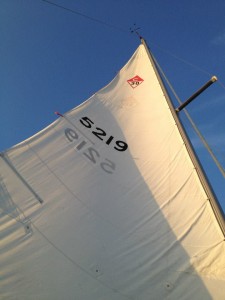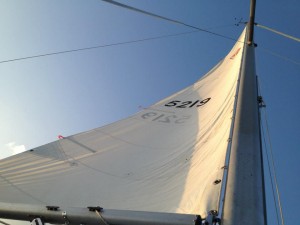Growing up by the water, it was inconceivable to me that other kids did not have beaches and boats as their playgrounds. I guess we learned our way around the water just as kids from the city learned their way around the streets and subways. We knew to make plans by the tides; to judge wind direction by the breeze on our cheek; and how to tell a big storm was coming.
With the hard-earned money I made as a young teenager, I found and bought a very small wooden sailboat called a pram. It was heavy to move, and probably none too safe, but it was all mine. Looking back, I am surprised that my parents let me spend money on it instead of saving for college. Maybe they realized that there were lots of life lessons to be learned alone out on the harbor that would not be taught in a classroom.
We’ve been out on boats quite a bit in the heat of this summer. The principles of sailing are coming back to me and seem more than ever to parallel my music therapy work with families and young children. In a sailboat, the cloth sails are designed to catch the wind and the wind then either pushes the boat or pulls it along. This is called ‘lift’ – a lovely term. The sail, though, needs to be at a specific angle to the wind. There is no way to go directly into the wind – you just need to adjust your sails so the wind supports movement from the side or from behind. This makes the journey like a zigzag, called ‘tacking’. You can rarely go in a straight line to where you want to go. It is always a back and forth dance. And so it is with children. Gentle pressure from behind and a calm acceptance of the pleasure of the journey over the destination is often the only way.
There is one sailing tenant that has particularly stuck with me lately as I watch my little ones in music. It is the concept called being ‘in irons’. As the boat tacks, or changes directions from side to side, it has a very brief moment in which the front of the boat points directly into the wind. The sails, that had just before been taut and responsive, become empty and limp. The boat begins to lose forward momentum. The sail and the sailor are for a split second frozen in limbo. I have watched this happen many times, and it is as if time stops and the world holds its breath. Boat, sail, sailor and passengers are locked in a state of intense focus but have no course of action except to wait. Just as suddenly, the wind once again catches on the opposite side and the sail snaps into place. The boat begins to move and everyone relaxes.
Without this moment of ‘stillness’ and anticipation, though, the boat would never get to its destination. The time of uncertainty and waiting without any observable reaction in the moment is absolutely a necessary part of the ultimate action.
Young children need, no require, a chance to be ‘in irons’.
Their newly forming self (body, thoughts, emotions, music) are dependent on time to attend and absorb and process before they can independently respond. Our job as leaders and nurturers is to recognize and respect those moments for young children. We also need to educate parents and other grownups about the importance for the child of being in ‘musical irons’. This can be difficult in our current approach to music experiences as being about producing and performing. We have come to value overt behaviors as the end product, rather than just a sign of internal growth and change. But just like the zigzag of sailing, watching children develop over the long term has given me the confidence that it is the time ‘in irons’ that allows for real growth and change. As I tell the moms, dads, grandmas and grandpas who come to our music group: for now, your little one just has to ‘be’, they don’t have to ‘do’.
Recognizing ‘musical irons’ in young children:
- ‘Musical irons’ often result as the child hears new musical material or looks forward to a favorite musical moment
- The child stands very still and might seem oblivious to the environment
- The child’s body might be tensed and poised
- Their eyes are often wide open and intent on the source of the music
- The change in posture and attention is different from the child’s usual response
- Their mouths might be open and their hands and arms ready as if they are anticipating a response
- The moments are usually brief
Respecting ‘musical irons’ in young children:
- Be extremely observant for the subtle signs of ‘musical irons’
- Be flexible in musical tempo and structure pausing or slowing down to respect the state of the child
- Wait, wait, wait
- Show through your face and smile that you know the child is still actively present to the music
- Be ready to jump back into the music when the winds shift and the child moves through the moment back into action
- Educate others in the group on why ‘musical irons’ is important for young children
- Help grownups to be patient!
I know from sailing, that the wrong thing to do while ‘in irons’ is to frantically force the boat. Given calm and steady guidance, sailboats, like children, will most often find their way through this critical moment and will once again move forward.


